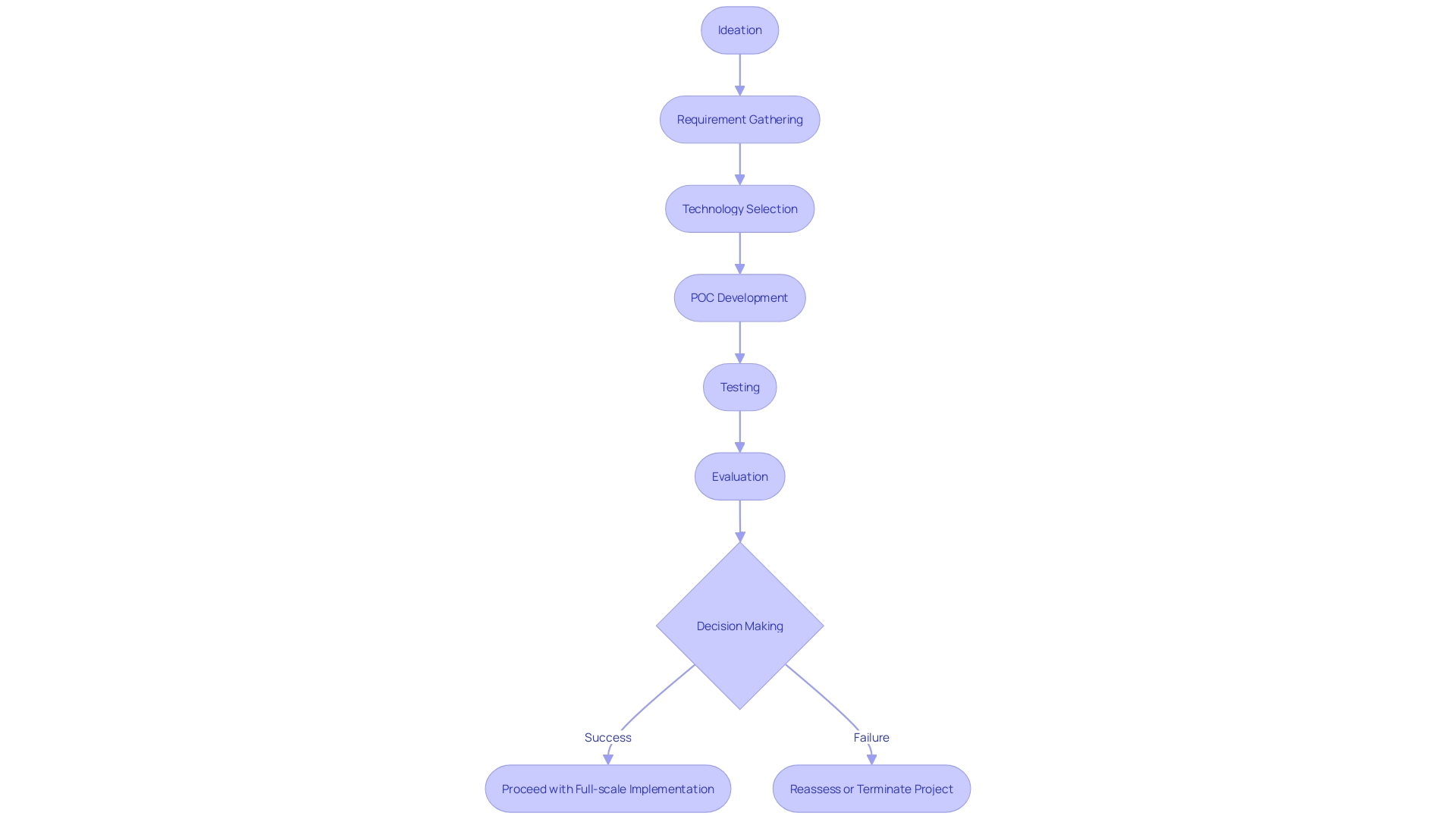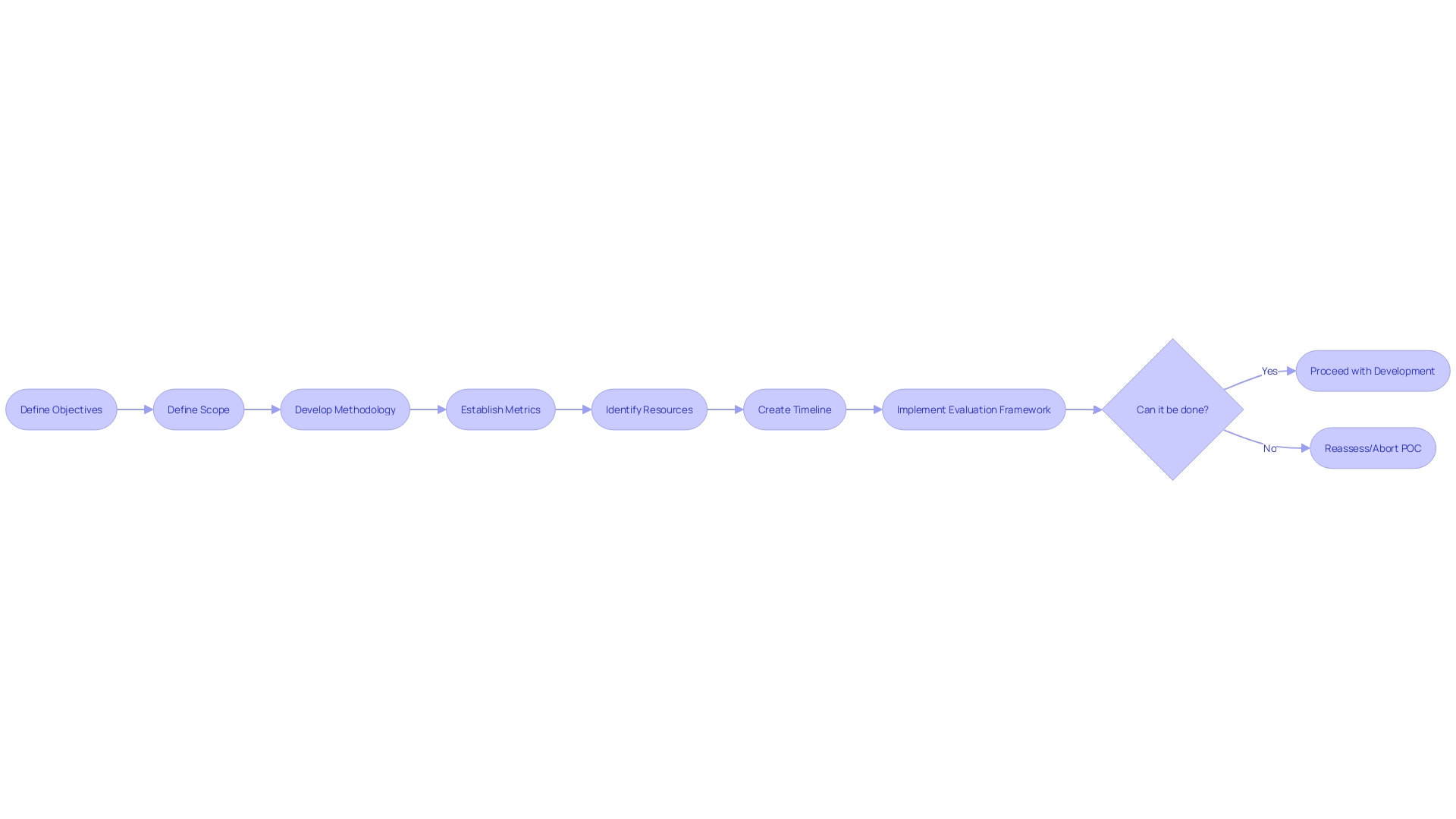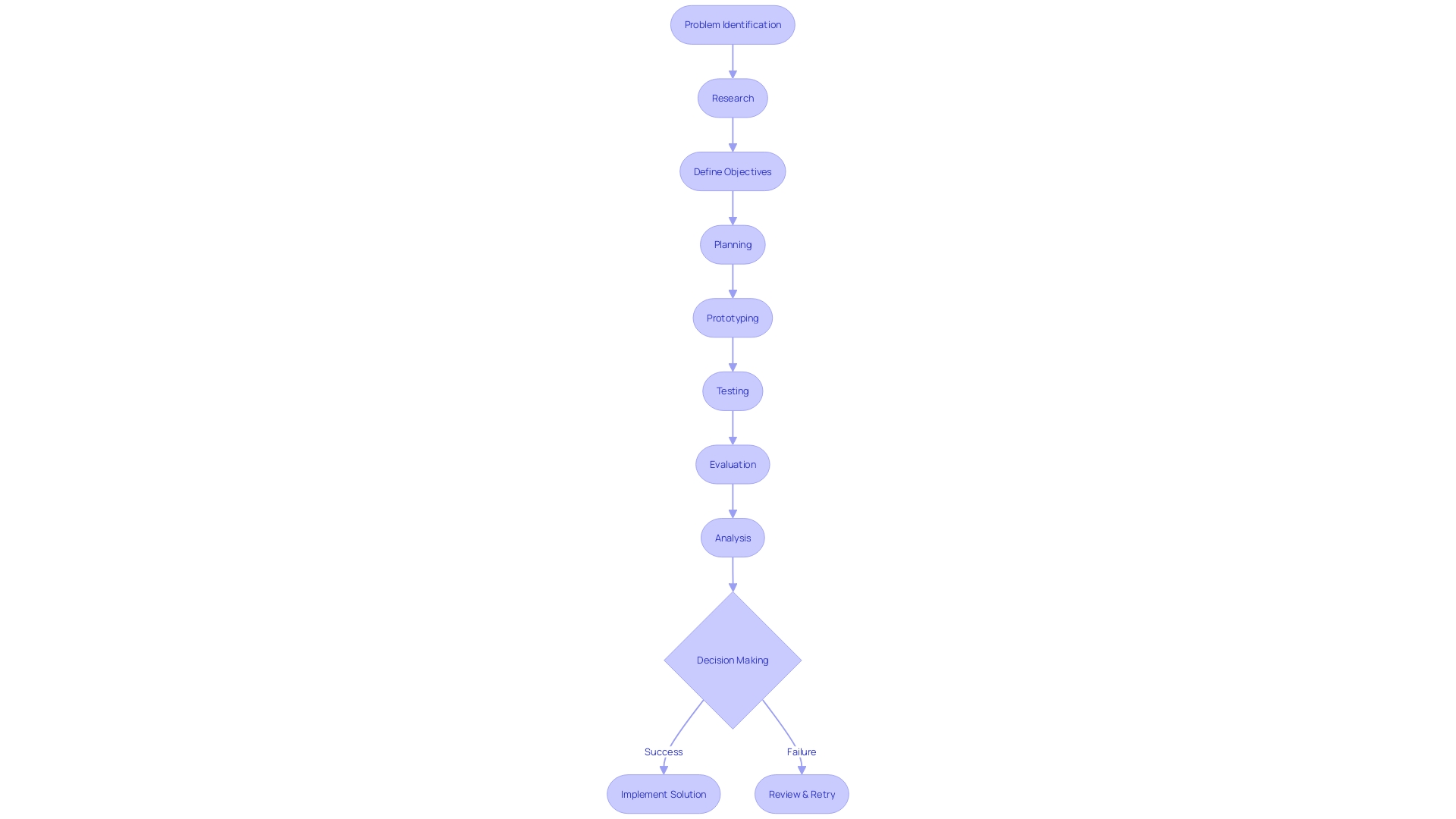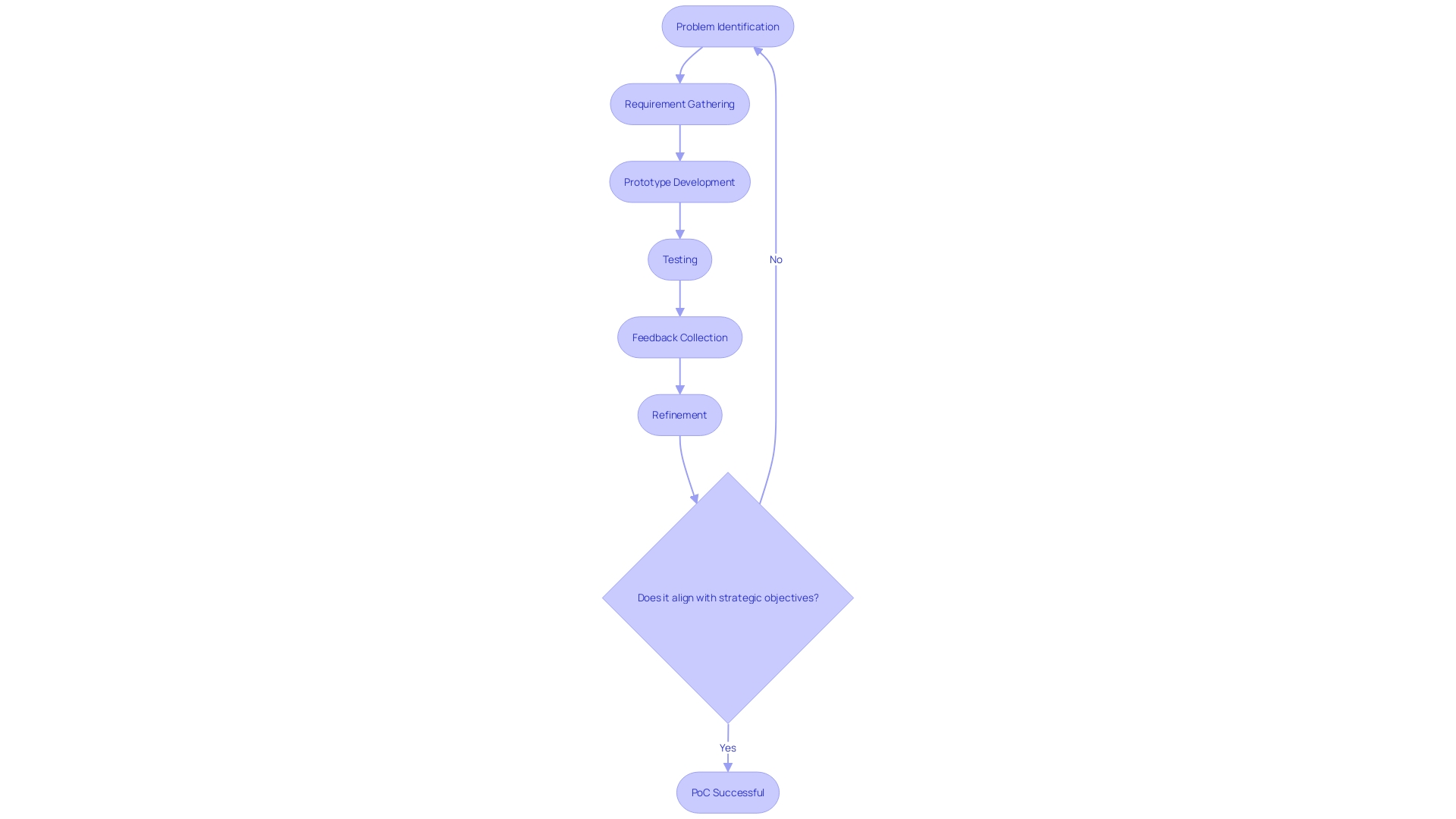Introduction
In the rapidly evolving landscape of business and technology, a Proof of Concept (POC) serves as a critical bridge connecting innovative ideas with real-world application. This article explores the importance of POCs in evaluating the practicality and performance of new concepts or solutions on a small scale before widespread implementation.
It delves into key components of a POC, the process of creating one, and provides examples across various industries. By understanding the differences between a POC and a prototype, businesses can effectively navigate the challenges of innovation and secure their place in the future market. With the global market for smart home automation projected to reach $40 billion, the insights shared in this article are invaluable in driving strategic decision-making and ensuring cost efficiency.
What is a Proof of Concept?
In the rapidly evolving landscape of business and technology, a Proof of Concept (POC) serves as a critical bridge connecting innovative ideas with real-world application. As businesses merge their strategies with technological advancements, a POC becomes an invaluable tool to test the practicality and performance of a new concept or solution on a small scale before rolling it out widely. It answers the pivotal question, "Can it be done?"
by focusing on the technical feasibility without the initial pressure of demonstrating business value or return on investment. For instance, in the burgeoning field of home automation using IoT, a POC can help in understanding how a smart device might integrate and communicate within an existing ecosystem, a market which is projected to reach $40 billion by 2020. The synergy between business users and IT departments is paramount when selecting the right technology.
Business users, with their intimate knowledge of the problems at hand, can pinpoint the exact requirements, while IT professionals leverage their technical expertise to identify the most suitable solutions. This collaboration not only accelerates the time to market for new products but also enhances productivity by ensuring that the chosen technology aligns perfectly with the business needs. Conducting a POC allows for a controlled exploration of potential challenges, significantly mitigating risks and ensuring cost efficiency compared to full-scale development, thus laying the groundwork for successful implementation and future scalability.

Why is Proof of Concept Important?
In the genesis of any innovative IT project lies the crucial step of nurturing an idea through its infancy. This idea often springs from the fertile grounds of academic or industrial research, rooted in scientific discoveries or engineering breakthroughs.
These concepts may hold the potential for practical applications that aren't immediately apparent. The individuals spearheading the project must be intimately familiar with the research environment to understand and bridge the gaps that exist between the raw technology and its commercial viability.
As emphasized by Jared Spool, an expert in the field of software design, the process is akin to an architect who meticulously constructs a scale model before building the actual structure. This model serves as both a blueprint and a tool to convey the vision and address potential complexities.
Similarly, a Proof of Concept (PoC) in software development acts as a critical intermediary stage. It's not just about the raw code; it's about crafting a tangible model that can be interactively experienced by developers, stakeholders, and users, offering an early preview of the final product.
The value of a PoC extends beyond mere visualization. It's an experimental proving ground that allows businesses to evaluate how an idea performs in a controlled environment. It's a strategy for mitigating risk and ensuring cost efficiency. A PoC is an investment in foresight, especially given the challenges associated with digital transformation and achieving measurable business outcomes, as indicated by a recent IDC survey. In a world where the smart home automation market is projected to reach $40 billion, and the Internet of Things (IoT) continues to weave into the fabric of daily life, the PoC is not just a step but a strategic imperative for businesses aiming to navigate the complexities of innovation and secure their place in the future market.
Key Components of a Proof of Concept
To ensure a Proof of Concept (POC) serves its purpose effectively, it needs to be meticulously planned and executed with a clear understanding of its components. The POC starts with a well-defined objective, which is to evaluate the practicality of an idea born from scientific discoveries or engineering innovations.
Often originating in research environments, these ideas require a founding team that's intimately familiar with the technology and the scientific or technological gaps that must be bridged for commercialization. To shape these ideas into a viable POC, a scrappy mindset and a ruthless focus on execution are essential.
Setting a scope is crucial to determine the POC's boundaries, ensuring it remains a manageable size. A strategic methodology is then developed, outlining the steps to take the POC from concept to reality.
Metrics are established to measure the POC's success, with a focus on technical feasibility over immediate business value or ROI. This echoes the sentiment that a POC aims to answer the fundamental question, 'Can it be done?'
rather than 'What is the business value?' Resources are identified, including the necessary tools and technologies, to support the POC.
A realistic timeline is crucial to keep the project on track without rushing the process, which could lead to oversight of potential issues. Finally, an evaluation framework is put in place to assess the results. This is akin to an architect creating a scale model before constructing a grand building, as noted by Jared Spool. It allows for a clear visualization of the end result and understanding of complexities, serving as a visual and often interactive model of the concept. With the global market for smart home automation, such as IoT, projected to reach $40 billion, the role of a well-executed POC in navigating the challenges of new technologies becomes even more significant. A POC offers a controlled environment to identify and mitigate potential risks early on, making it a cost-effective strategy compared to full-scale implementations.

How to Create a Proof of Concept
An effective Proof of Concept (PoC) is a strategic undertaking that begins with a clear identification of a problem or opportunity. It is critical to conduct extensive research to understand the industry context and existing solutions, as well as to anticipate possible challenges. Defining the objectives and criteria for success is essential to evaluate the PoC's effectiveness.
A detailed plan, which includes scope, methodology, timeline, and resources, lays the groundwork for success. Building a prototype allows for the testing of functionality and performance on a smaller scale. Through testing and evaluation, data can be collected to assess feasibility and potential impact.
The final step is to analyze the results, which leads to informed decision-making regarding full-scale implementation or necessary adjustments. For instance, Nets, a digital payment solutions provider, faced the challenge of presenting technical data in an accessible format. They transformed complex tables and schemes into engaging content, encouraging users to explore information independently.
This approach aligns with the principles outlined in Alistair Cockburn's 'Writing Effective Use Cases,' which emphasizes the importance of clear and effective communication between business and engineering teams. Furthermore, the CHAOS Report's findings indicate that only 30% of IT projects are completed successfully, while 20% fail, and 50% face challenges. This underscores the importance of PoCs as a risk mitigation tool.
The Internet of Things (IoT) market, projected to reach $40 billion by 2020, exemplifies the need for PoCs in the face of rapid technological advancement. PoCs provide a controlled environment to explore new concepts like IoT, ensuring alignment with strategic business objectives. They are not only a means to test technical feasibility but also a cost-effective approach to innovation, allowing businesses to navigate unproven territory with confidence.

Proof of Concept Examples
Proof of Concept (PoC) initiatives are pivotal for businesses venturing into new technological territories. For instance, in the realm of software applications, a PoC may involve creating a basic version of the application to evaluate its core functionalities and the overall user experience.
This is crucial in software development, where agile methodologies have replaced the rigid waterfall approach, allowing for iterative testing and refinement of the software through user feedback. In the burgeoning field of the Internet of Things (IoT), where the global market for smart home automation is anticipated to hit $40 billion, a PoC could entail constructing a prototype IoT device to verify its connectivity and performance.
This step is indispensable as it addresses the five prevalent challenges in IoT, ensuring a smooth integration into the increasingly digital fabric of our lives. Similarly, for business process optimization, a PoC serves to fine-tune a particular process, aiming to enhance efficiency and productivity.
This aligns with the concept of Industry 4.0, which emphasizes the integration of data sources to elevate operational efficiency and achieve higher overall equipment effectiveness (OEE). Moreover, when it comes to new product development, creating a prototype is a strategic move to assess design, functionality, and market viability before a full-fledged launch. This approach is backed by the agile philosophy, which affirms the importance of adaptability and learning through the development cycle, thereby avoiding the pitfalls of the waterfall model's 'set in stone' specifications. Ultimately, PoCs are essential for risk mitigation and cost efficiency, providing a sandbox for innovation while aligning with strategic business objectives.

Proof of Concept vs. Prototype
Understanding the differences between a Proof of Concept (POC) and a prototype is crucial in the realm of IT development. A POC is essentially a small-scale project that tests the feasibility of an idea or technology solution. It's not about demonstrating the potential return on investment, but rather answering the question, 'Can it be done?'
This is particularly relevant in cutting-edge fields like computer vision, where the progress is rapid and the need for a supportive community and thorough documentation is paramount. Conversely, a prototype is a working model that exhibits the design and functionality of the proposed product. It acts as a visual and interactive representation, akin to an architect's scale model, which is instrumental in understanding the intricacies of the project and refining it before it enters the production phase.
Jared Spool eloquently compares the prototype to an architect's miniature scale model, highlighting its role in visualizing the end result and iterating on the design. In the dynamic world of smart home automation, where the market is expected to reach $40 billion, and the Internet of Things (IoT) is becoming increasingly integrated into everyday life, these development stages are more important than ever. They allow for a controlled exploration of innovative concepts, leading to cost-effective and risk-mitigated solutions that align with strategic business objectives.
Conclusion
In conclusion, a Proof of Concept (POC) is a critical tool for evaluating the practicality and performance of new ideas or solutions on a small scale before widespread implementation. By setting clear objectives, defining scope, and following a strategic methodology, businesses can mitigate risks and ensure cost efficiency. POCs play a crucial role in navigating the complexities of innovation and securing businesses' place in the future market.
They provide a controlled environment to identify and address potential challenges early on, aligning with strategic objectives. In fields like smart home automation and IoT, where the market is projected to reach $40 billion, POCs are essential for exploring new concepts and technologies. It's important to differentiate between a POC and a prototype.
A POC focuses on feasibility without demonstrating return on investment, while a prototype showcases design and functionality. Both stages contribute to visualizing the end result and refining ideas before full-scale implementation. By embracing POCs as invaluable tools in decision-making, businesses can navigate innovation challenges effectively.
With the global market for smart home automation projected to reach $40 billion, leveraging POCs becomes even more crucial in securing businesses' position in the future market. Investing in well-executed POCs enables businesses to evaluate new concepts before widespread implementation, ensuring cost efficiency and staying competitive in the rapidly evolving market landscape. So, it is imperative for businesses to prioritize POCs as they drive strategic decision-making processes and pave the way for successful innovation adoption.





